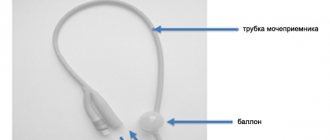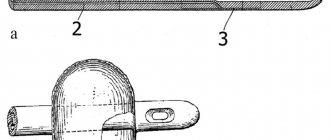Catheterization is emptying the bladder using a urological catheter. Periodic (intermittent) catheterization is performed approximately 6 times a day to remove urine from the bladder. Intermittent catheterization is most often performed using a Nelaton catheter. The catheter is inserted through the urethra into the bladder and removed immediately after urine drains from it.
Self-catheterization is the process of self-insertion of a catheter by a patient to drain urine when physiological urination is impossible.
Before performing self-catheterization, it is necessary to undergo appropriate training from medical personnel. They will help you choose the right catheter size and provide instructions. Nelaton catheters, in addition to size, differ in material, presence and type of lubricant, and devices for ease of use. The price of Nelaton catheters also depends on this. For men, Nelaton catheters are longer and have a length of 40 cm, for women and children 20 cm.
A catheter with a Thiemann tip is mainly used for catheterization of the bladder in patients with obstructive pathology of the urethra.
Our Mystoma store has a large selection of Nelaton catheters. Our specialists will help you select and buy a Nelaton catheter
We present brief instructions for using Nelaton catheters; for more detailed information, read the packaging for your catheter.
General recommendations for catheterization:
1. To avoid urinary tract infections, use hand sanitizers and perform genital hygiene before catheterization. If there is no water, use sanitary napkins for intimate hygiene.
2. To prevent the development of infection, the bladder must be completely emptied. To avoid the accumulation of residual urine, in order to completely empty the bladder, you must take a comfortable position before starting the procedure.
3. It is necessary to monitor the color of urine, its transparency and the presence of various impurities. If your urine becomes cloudy, dark, and there is a sharp unpleasant odor, if you feel a burning sensation in the bladder area, as well as an increase in body temperature, consult a doctor immediately, as these may be signs of infection.
4.You should not allow your bladder to overfill. Catheterization must be performed every 3-4 hours or more often depending on the drinking regime.
5. If an attempt to insert or remove a catheter the first time is unsuccessful, then try to relax and try again after a while. To relax, do breathing exercises (deep breath, exhale), cough.
6.Usually, in the absence of catheterization difficulties, bladder emptying occurs in 3-4 minutes.
Pediatric Foley catheters
Children's Foley (Pomerantsev) catheters are presented in a wide range in our Maistoma store. Leading world-class companies produce high-quality Foley catheters for catheterization of people, including children. Foley catheters Vogt Medical (Vogt Medical), Convatec (Konvatek) children's two-way at a competitive price with fast delivery throughout Russia. Pediatric Foley catheters are designed for urine diversion, bladder lavage, diagnostic and therapeutic procedures in children.
Types of Foley catheters
A two-way Foley catheter is a tube that is inserted into the urethra. There are holes at the end of the tube through which urine flows from the bladder, along the main course of the catheter. After this, the balloon is inflated, which fixes the catheter in the bladder for a long period. The balloon is inflated through a special (second) passage with sterile liquid. There are also three-way Foley catheters , the third port is used to administer medications into the bladder.
Foley catheter materials
A Foley catheter is designed for long-term catheterization; it can remain in the bladder for up to several months, depending on the material from which it is made. The longest catheterization is provided by silicone silver-plated Foley catheters, up to 90 days. 100% silicone Foley catheters last up to 30 days. Latex Foley catheters up to 7 days. Silicone provides such long-term catheterization because it is a biocompatible material. The physicochemical properties of silicone prevent the deposition of salts inside the catheter. The presence of silver provides an antibacterial effect. Latex Foley catheters are coated with silicone - siliconized. This gives better biocompatibility to catheters, minimizes the risk of unwanted allergic reactions, and also protects the mucous membrane of the urethra. A latex Foley catheter is less expensive than a silicone catheter. But also a shorter period of use.
The pediatric Foley catheter is 28 cm long and often comes with a stylet to facilitate insertion into the child's urethra. The volume of the inflated balloon is 3-5 ml.
Sizes of pediatric Foley catheters:
The sizes of pediatric Foley catheters on the Charrière scale are 6 CH, 8 CH and 10 CH. Foley catheters are color coded on the connector according to size.
Catheters are numbered according to the Charrière scale and the size is selected according to the table:
Table, Foley catheter sizes:
| Floor | Size | Connector color | Inner diameter | External diameter | Length | Cylinder volume |
| Children's | Ch 6 | pink | 1.1 mm | 2.0 mm | 28 cm | 3-5 ml |
| Children's | Ch 8 | black | 1.7 mm | 2.7 mm | 28 cm | 3-5 ml |
| Children's | Ch 10 | grey | 2.3 mm | 3.3 mm | 28 cm | 3-5 ml |
How are catheters installed?
All types of catheters are installed by a qualified nurse according to a specific algorithm. Bladder catheterization is performed as follows:
- The patient lies on his back, legs bent at the knees and apart, and feet together. This way the genital muscles relax and insertion of the tube does not cause pain.
- The nurse puts on sterile gloves, wipes the genitals with an alcohol solution, coats the tip of the catheter with a large amount of lubricant and carefully inserts it into the urethra.
- The tip of the device is pushed forward into the bladder until urine begins to flow from the tube into the container.
- The device is fixed with an adhesive tape.
Another type of catheterization is the installation of a cystostomy. This is a special device for draining urine through an incision in the abdomen, bypassing the urethra. Installed in the operating room or on an outpatient basis.
Bladder catheterization can be short-term (during operations, drug administration) or long-term. For long-term use, a convenient Foley probe is often used, the design of which helps to remove urine, administer medications, and flush the bladder.
When installing a venous catheter, the puncture site is wiped with alcohol. Then a tourniquet is applied to the limb to fill the vein. The skin is stretched and the cannula is inserted at a certain angle. The needle is then withdrawn, leaving the catheter in the vein. A plug is placed on the other end of the catheter.
Common symptoms and manipulations in urology:
- Pain when urinating
- Discharge from the urethra
- Itching in the urethra
- Short frenulum of the foreskin
- Prostate massage
- Prevention of casual sex
- Frenum plastic surgery
- Circumcision
- Kidney pain
- Perineal pain
- Stones in the kidneys
- Pus in urine
- Catheter removal at home
- Bougienage of the urethra
- Urinary retention
- Urological examination
- Papillomas on the foreskin
- erectile disfunction
- Make an appointment with a urologist
Urological catheters: types and characteristics
Urological catheters
Urological catheters are tubular medical products.
Designed for removing urine, washing, introducing medicinal solutions or surgical instruments into the bladder for manipulation procedures. Indications for catheterization
| Therapeutic indications | Diagnostic |
|
|
Main characteristics
Urological catheters made from modern materials have the following characteristics:
- biological compatibility;
- chemical inertness, stability;
- hypoallergenic;
- atraumatic.
Materials
Latex, silicone or polyvinyl chloride are modern materials used in the production of urological tubes for removing urine from the bladder in case of obstructed outflow.
Terms of use
Latex products have the shortest shelf life - no more than a week. Silicone - up to a month. Silver-plated catheters can be inserted into the bladder for up to three months.
Types of catheters
The choice of product depends on the condition, age and gender of the patient, the expected period of use, and the type of manipulation. Each brand has different length and sizing options. Devices are produced in sterile packaging.
Kinds:
- soft or hard;
- disposable, reusable;
- intended for long-term catheterization of the bladder;
- children's, women's, men's.
Malekot (Pezzera) catheter
Purpose – long-term removal of urine from the bladder through a cystostomy. Recommended for patients with acute urinary retention and various types of urethral damage.
A cystostomy is a tube that is inserted for a long time through the peritoneal cavity into the bladder. The outflow of urine occurs into a special urinal.
Nelaton catheter
Designed for repeated (up to 4-5 times a day) urine removal in case of impaired natural urination. It is made of PVC, has thermoplasticity (it becomes soft at body temperature), and is equipped with an olive-shaped tip, which simplifies its insertion into the cavity of the bladder. Lubricated Nelaton tubes are prescribed for self-catheterization. Women's and children's are available in lengths of 20 cm, men's - 40 and 45 cm.
Nelaton catheter with Thiemann tip
A special bend makes it easier to insert the tube. Used for short-term catheterization.
Thiemann catheter (Mercier)
Used to remove urine in men. Used in the presence of benign prostatic hyperplasia.
Prostatic hyperplasia, or adenoma, is a tumor of the glandular tissue of the prostate gland.
Foley catheter
A soft tube with a special balloon that allows you to fix the catheter in the bladder. The design of the catheter with two or three holes (two- and three-way) allows not only to drain urine, but also to administer medications, remove blood clots, and wash the cavity of the bladder and urethra. The duration of catheterization is up to 7 days.
Catheterization algorithm
General rules for women, men and children:
- Perform thorough toileting of the genitals. Children are helped by parents or medical staff.
- Lie on the couch with your back, spread your legs and bend them at the knees, place a bedpan or oilcloth under your buttocks. Children, especially restless ones, need adult help.
Algorithm for a medical worker
General rules for medical personnel:
- Prepare a set of tools and materials. Sterile: catheters, tray, containers for collecting urine for analysis, medical gloves, tweezers, Janet syringe, diapers, oilcloth. Antiseptic, petroleum jelly or glycerin, furatsilin solution.
- Place the patient on the couch, place an oilcloth under the buttocks, then a vessel or tray for urine.
- Wear sterile gloves and treat the patient's external genitalia with antiseptic agents.
- Carry out the necessary manipulations, if necessary, attach a urinal to the catheter.
- Make a note about the procedure performed in your medical record.
Catheterization for a man
Male urological catheter is long, thin, curved. This characteristic is associated with the anatomical and physiological features of the urethra, its two S-shaped bends.
Algorithm:
- Place the patient on the couch, treat the external genitalia, wipe the head with a napkin containing furatsilin.
- Gently squeeze the head of the penis to open the opening of the urethra.
- Insert the catheter, pulling the penis gently upward.
- Collect urine and carry out the necessary medical procedures (washing, treatment, removal of blood clots).
- Pull out the catheter and treat the head of the penis with an antiseptic.
Carrying out the procedure for a woman
The female urethra is shorter, straighter, and wider. Therefore, catheters have these features and are up to 20–30 cm long. In gynecology, a Foley tube is used to stimulate the uterus before childbirth.
Algorithm:
- The patient and medical staff follow the general rules for preparing for catheterization.
- The nurse covers the woman's pubis with a sterile napkin and spreads the labia to expose the urethral opening.
- The doctor or nurse lubricates the female urological catheter with glycerin or petroleum jelly and inserts it into the urethra to a depth of 4–5 cm.
- Releases urine into the prepared tray.
- If necessary, collects it for biochemical or bacteriological research.
- According to indications, the doctor carries out medical procedures (washes the bladder, administers medicine).
- After completing the procedure, the catheter is carefully removed, the external genitalia are treated with antiseptics and dried with napkins.
- After 5–10 minutes the patient can be free.
Carrying out the procedure for a child
Children's instruments for removing urine differ from adults in shorter length and diameter.
Algorithm and recommendations:
- For infants, the procedure is performed only by a doctor.
- The urological catheter for children is selected in the smallest size.
- The urinary tube is inserted 2 cm into the bladder.
- Release, collection of urine, and drug therapy are carried out.
- The tube is removed very carefully and the genitals are carefully treated.
- The child is given 15–20 minutes to recover after the procedure.
Self-catheterization
Urine removal can be done by both men and women themselves. Body position, types of catheter, frequency of the procedure are determined by the doctor after a thorough examination of the patient, taking into account gender, age, and concomitant diseases. It is not recommended to select a catheter without consulting a doctor, since the diameter of the tube must correspond to the size of the urethra and urethral canal.
The extensive range in our online catalog allows you to select urological catheters taking into account the anatomical and physiological characteristics of the patient and ease of use. Disposable products made from modern materials ensure safety and comfort of catheterization, reduce the likelihood of infection and complications.
Indications
There is a whole list of pathological conditions for which an external male urological catheter of one of the mentioned types is used. For diagnostic purposes, this device is used to introduce contrasting components into the bladder cavity, followed by its subsequent X-ray examination.
In addition, the contents of the bladder are collected through a catheter for bacteriological and cytological examination. If the patient is in the rehabilitation period after surgery, then this procedure will allow medical specialists to monitor the level of daily diuresis.
As a therapeutic measure, the procedure for installing a urinary catheter is used for pathologies accompanied by disruption of the process of natural urine output. The most common reasons for performing this manipulation include:
- Kidney tuberculosis;
- Glomerulonephritis;
- Benign hyperplastic changes in the prostate;
- Blocking of the lumen of the ureter with renal stones in urolithiasis;
- Benign or malignant neoplasms that exert mechanical pressure on the urethra;
- Other reasons that contributed to the narrowing of the lumen of the urethra;
- This device is indispensable when it is necessary to directly administer antiseptic, anti-inflammatory and antibacterial drugs directly into the bladder cavity;
- Catheter placement is also performed in seriously ill patients, as well as in unconscious people.







